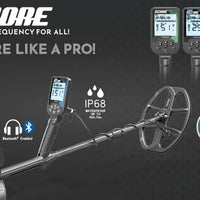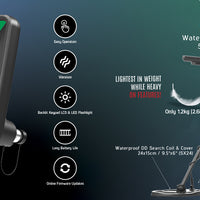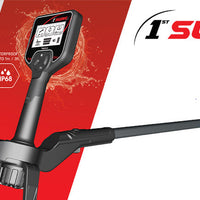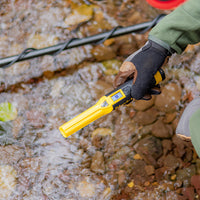If you want to know how to detect gold, you need to invest in metal detectors that are specifically designed to find gold nuggets. But how does a gold detector work? What is the working principle behind this technology that enables it to identify gold nuggets from other items?
In this guide, you will learn more about how this technology works. You can use this information to educate your decision if you are shopping for detectors that can identify this type of object during your treasure hunt.
How to Detect Gold: Working Principles
If you are looking to buy metal detectors designed specifically for gold prospecting, you might be curious to know about the mechanism of these devices. It is important to understand the working principle of gold detectors to help you choose the right model that can get the job done.
At first glance, gold detectors look a lot like any regular metal detector. But it is actually composed of different components that enable it to identify gold nuggets apart from other metal objects.
The working principle of a gold detector is that it transmits electromagnetic fields into the ground. It then processes the signal that is coming off that field based on how it reacts to pieces of metal that are buried beneath the ground. The electromagnetic field is produced using an electrical current from a power source. For most gold detectors in the market, this is powered by alkaline batteries. In some cases, the electromagnetic field is generated from within the search coils itself.
There are different parts that make up a metal detector. Each of these parts has a vital function to play. You can learn more about these parts below:
- Stabilizer – This is a practical attachment that makes it easy for you to use a metal detector. It provides stability (as the name implies) as you move it around to detect gold or other objects.
- Control Box – This serves as the brain of your device. This is where the battery, device control and settings, processor, and readout are located. The speaker is also located within the control box.
- Shaft – It serves to connect all of the different parts of a gold detector together. This can be adjusted according to your preference.
- Search Coil – It is located at the bottom of the gold detector and one that comes into contact with the ground. It is responsible for sweeping through the ground to identify if there are any objects of interest.

Search Technologies for Gold Detectors
Now that you know the basic working principle and parts of a metal detector, it is now time to move on to the next step. You need to understand the various search technologies in use that allow you to identify gold nuggets on the ground.
There are two main types of search technologies used for gold detectors: 1) very low frequency (VLF) and 2) pulse induction technology.
Very Low Frequency Technology
The Very Low Frequency (VLF) technology is one that is commonly used in gold detectors. It is cheap and easy to manufacture.
There are two types of coils used in metal detectors that employ this technology. The first one is a transmitter coil, which is made with a coil of wire. Electricity is fed onto the coil of wire that allows the current to travel to multiple directions in a matter of seconds. This helps to establish the unit’s frequency level.
The second one is the receiver coil that makes up the inner coil loop. It is responsible for picking up any frequencies on the ground and then amplifying that.
The VLF technology is able to distinguish gold from other types of metal using a phenomenon known as phase shifting. This refers to the difference in timing between the frequencies of the transmitter coil with that of the target object on the ground.
For example, an object with high inductance will create a large phase shift since it takes more time to alter the magnetic field emitted from the coil. On the other hand, an object with high resistance will have a small phase shift.
There are several gold detectors in the market that employ VLF technology for detecting gold nuggets.
Pulse Induction Technology
The other technology used for gold metal detecting is pulse induction technology. This is not as common as the VLF technology but is still as effective for gold prospecting.
The main difference right off the bat is that detectors that employ this technology only make use of one coil (not two). It works by sending short yet powerful bursts of current through the coil of wire. The pulse is responsible for producing a brief magnetic field. As soon as the pulse ends, it creates a short electrical spike.
This spike of electricity extends throughout the coil, which is known as a reflected pulse. This process is repeated as more short but powerful pulses are emitted. On average, gold detectors that employ this technology are able to send 100 pulses per second. However, this range can vary significantly depending on the model.
When the device comes into contact with a metal object, it creates an opposite pulse to the magnetic field.

How to Detect Gold: How to Choose Metal Detectors
Use the above information to help understand the technology behind detectors used for gold prospecting. There are many models in the market designed for hunting gold and they are not made the same.
By understanding the technology behind finding gold, you can choose the best features and technologies in a metal detector. If possible, make sure to shop for metal detectors that are specifically designed for gold prospecting since they offer advanced capabilities to discriminate gold over other types of metals.
Some advanced users and professionals can buy any regular metal detectors and they tweak the setting to distinguish gold (from other metals). But if you invest in gold detectors, you can make your life easy because the settings are readily available for this purpose. You can get to gold hunting right away and you won’t have to worry about getting the settings right.







0 comments